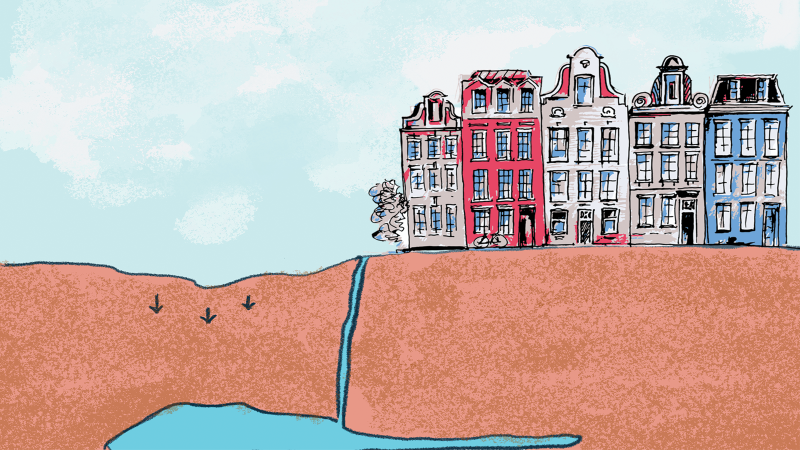
Jakarta, one of the most populated cities in the world, presents a bleak picture — the city is sinking 10 inches per year, and North Jakarta is projected to be underwater by 2030. Sinking is primarily caused by the excessive extraction of groundwater. The city is already experiencing extreme flooding, and buildings have shrunk, leading to cracks in its foundations..
Land subsidence is the gradual or sudden shrinking of the earth’s surface due to the removal of the underlying materials, especially groundwater. It is projected that around 8% of the world’s surface will sink by 2040, putting more than 635 million people at risk. This risk is multifold — sinking surfaces make the land more vulnerable to floods amidst rising sea levels. All human constructions such as buildings, houses, roads become prone to damages, including cracks and weakening foundations.
Researchers from the Department of Engineering, University of Cambridge, along with researchers in the Indian Institute of Technology Bombay, the Institute for Photogrammetry and Geo-Information, Leibniz University and the Remote Sensing and Geoinformatics, GFZ German Research Centre for Geosciences studied the land subsidence due to groundwater depletion around the National Capital Region (NCR, Delhi). They found alarmingly high rates of land subsidence in the region, coinciding with the decrease in groundwater levels. The results were published in the journal Nature Scientific Reports. The study was funded through Projekt Deal which is run by the German Rectors’ Conference.
India is the world’s largest user of groundwater. More than 80% of the population is dependent on groundwater for drinking and agricultural purposes. The Central Groundwater Board of India estimated that around 17% of groundwater aquifers in the country are over-exploited, which means the water extraction rate is higher than the water refill rate. Overexploitation causes severe depletion in groundwater resources, especially in the north-western, western and southern peninsular regions. A secondary outcome of this is the increase in land subsidence.
The researchers used the surface mapping data of the NCR area, obtained via satellite imaging and sensing (Sentinel-1 datasets) for the years between 2014 and 2020. They calculated land subsidence using the Stanford Method for Permanent Scatterers (StaMPS). This technique measures surface deformations in different areas using surface mapping data. The difference in signals from the sensors within the time frame gives the extent of land subsidence.
The researchers divided the time frame from 2014 to 2020 into three phases- Phase 1 (2014–2016), phase 2 (2016–2018), and phase 3 (2018–2020). In addition to the land subsidence calculation, the researchers generated a risk map of the area, dividing the region into low, medium and high risk. To study the relationship between land subsidence and groundwater depletion, the researchers used groundwater data from the Central Groundwater Board and processed it to produce a groundwater depth map. They compared the change in groundwater depth with the subsidence rates to understand the relation between the two.
One of the key takeaways from the analysis was that heavy groundwater depletion caused land subsidence, mainly in urban areas with high population densities. The heavy sinking of the surface and subsequent soil displacement left the drainage or sewer lines underneath the surface exposed and damaged.
The researchers identified three areas that showed interesting trends in land subsidence- Kapashera (Southwest-Delhi), Faridabad and Dwarka.
Kapashera, which lies in the vicinity of Gurgaon, Haryana and the Indira Gandhi International (IGI) airport, had a land subsidence rate of 11 cm/year in phase 1 (2014-2016), which grew to more than 17 cm/year during the next two phases. However, the surrounding areas sunk by only 1.5-4 cm/year. The subsidence is slowly moving towards the airport and might pose a danger to the structure if it’s not controlled.
Faridabad is among the fastest-growing cities in the world, driven by industrialization. This growth has been accompanied by excessive groundwater usage, mainly in the New Industrial Town region. The subsidence rate in Faridabad increased from 2.15 cm/year in phase 1 to 5.3 cm/year in phase 2. Phase 3 had a subsidence rate of 7.83 cm/year.
Dwarka, however, saw a declining trend in land subsidence from 2014 to 2020. From 3.5 cm/year in phase 1, it decreased to 3 cm/year in phase 2, while phase 3 saw a further decrease to 1.8 cm/year. The researchers posit that a multitude of reasons could cause the decline. In 2015, Dwarka residents revived a 200-year-old water body named ‘naya jhod’, which helped groundwater recharge. Similarly, in 2016, Delhi Jal Board made it compulsory to install a rainwater installation system in all properties bigger than 500 sqm to improve groundwater recharge. Previous studies have shown groundwater recharge improves soil rebound and reduces land subsidence.
“Understanding the geophysical properties of the high-risk areas and implementing strict measures for rainwater harvesting, punishing illegal groundwater mining and evaluating hazardous building conditions can go a long way in controlling land subsidence in the immediate future”, said Shagun Garg, PhD candidate, Department of Engineering, University of Cambridge and a co-author of this study.
The researchers generated a risk map of the entire region which showed a 100 sq. km. area that needs urgent attention from the authorities. Most of these areas have high population density and subsidence rates, including Bijwasan, Samalkha, Kapashera, Sadh Nagar 1, Bindapur, and Mahavir enclave from Delhi; Dundahera, Sector 22A, and Block C from Gurgaon; and Pockets of Sanjay Gandhi Memorial Nagar, from Faridabad.
The researchers feel that the groundwater situation in the Delhi NCR region is scary. The demand far exceeds the supply, a situation that is expected to deplete the resources further. In the future, this will lead to a drastic rise in land subsidence, putting many lives in danger. There is an urgent need to address these issues and look for potential solutions such as rainwater harvesting and water reuse to replenish the groundwater aquifers.
“In the longer term, we should think of alternatives to groundwater and rely on it as little as possible. Treating water and connecting every house to piped water supply can be one alternative”, Mr Garg concluded.
This article has been run past the researchers, whose work is covered, to ensure accuracy.






